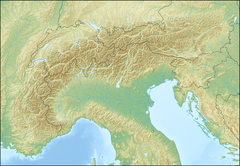La Rosière, Savoie
| La Rosière | |
|---|---|

A view of the valley from La Rosière
|
|
| Location | Montvalezan |
| Nearest city | Albertville, France |
| Coordinates | 45°37′38″N 6°50′57″E / 45.62720°N 6.84924°ECoordinates: 45°37′38″N 6°50′57″E / 45.62720°N 6.84924°E |
| Top elevation | 2,642 m (8,668 ft) |
| Base elevation | 1,850 m (6,070 ft) |
| Runs | 80 |
| Lift system | 38 |
| Total length | 160 km (99 mi) |
| Website | www |
La Rosière is a ski resort in southeastern France. It is located in the territory of the commune of Montvalezan, in the Savoie department, at 1,850 m (6,070 ft) above sea level and Template:Conbvert top height, and faces south with fine views across the valley to nearby Les Arcs.
It was developed in the early 1950s on the site of an old hamlet, and was linked with the nearby Italian resort of La Thuile in 1984 via two fairly long drag lifts through the Little St Bernard Pass.
Compared to its neighbour, Val d'Isère, La Rosière is relatively small, with 150 km (93 mi) of piste. The ski area of l'Espace San Bernardo (which includes La Thuile) caters for all abilities: as of early 2008, it provides 6 green and 23 blue slopes for beginners, and 32 red and 6 black runs for the more advanced skiers.
A notable feature on the higher pistes is the Redoute Ruinée, a border fort built by France in the early 1890s after the loss of Alsace and Lorraine to Germany in 1870, as part of a general strengthening of the borders. It was heavily reinforced between 1936 and 1940 as part of the Alpine Line, in anticipation of invasion from Italy. In June 1940, during the Battle of France at the start of World War II, a small force of 47 men resisted several attacks from Italy, before being allowed to leave with the flag after the Armistice with Germany. The fort suffered heavy damage when French forces attempted to retake it towards the end of the war. It is now ruined, and public access to the interior is prohibited for safety reasons.
Hannibal is thought to have marched his elephants through this area on his passage through the Alps.
...
Wikipedia

